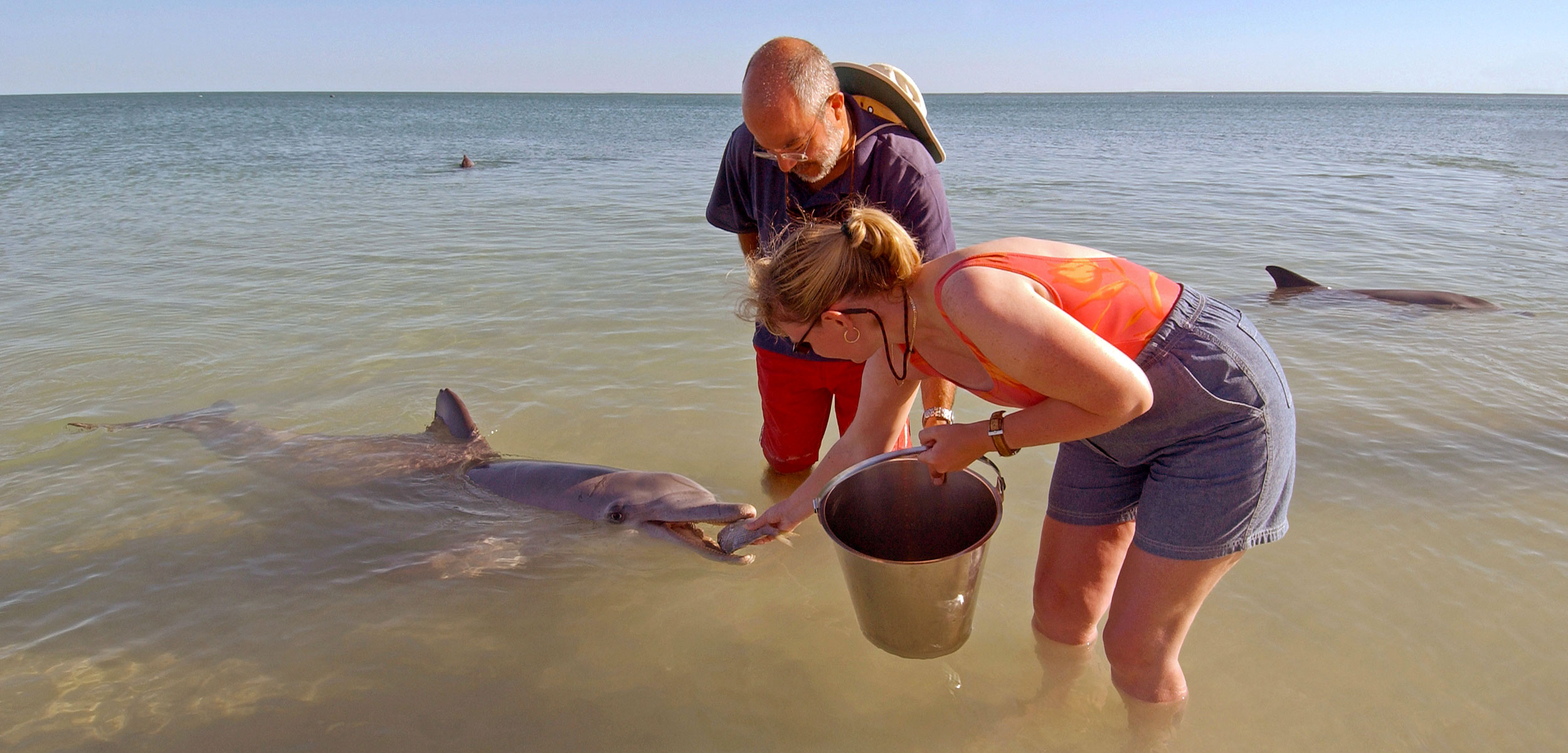When Dolphin Moms Are Fed by People, Their Babies Suffer
Juvenile dolphins whose mothers are fed by volunteers at an ecotourism operation are much less likely to survive.
Article body copy
Off the coast of Bunbury in Western Australia, tourists wade waist-deep to get close to wild Indo-Pacific bottlenose dolphins, which show up day after day, lured by fish given out by volunteers.
The dolphins in Bunbury are under threat by boat traffic and an expanding port. Over the next 20 years, their population of about 200 individuals is expected to dwindle by 50 percent. While it would be easy to think a handout will save these imperiled dolphins, new research by Valeria Senigaglia, a doctoral student at Murdoch University in Australia, suggests this tourism-focused feeding program is doing more harm than good.
“Among the many variables that can affect the survival of a calf, apparently, having a mother fed at the beach for tourism purposes is the most detrimental,” says Senigaglia.
Feeding marine mammals is illegal in Australia, but the government permits it at four ecotourism locations, including Bunbury. Drawing on data collected from 2007 to 2016, Senigaglia examined the survival rates of calves born to 63 female dolphins, including eight that were fed at Bunbury. The study examined a range of factors, including climate events like El Niño and La Niña, which affect prey availability, and human disturbances such as noise, pollution, and shipping.
Ultimately, the feeding program had the most dramatic effect. Senigaglia found that only a third of the calves from mothers that had been fed survived to weaning age, around three years old, while calves from unfed mothers had a 75 percent survival rate.
Senigaglia suspects that because their mothers are spending so much time feeding at the beach, the youngsters are missing out on training and protection. Dolphins stay safe from predators by sticking with the group, and calves learn from their mothers and from playing with their peers, forming alliances that will help them later in life. Without these relationships, the calves are more vulnerable.
This finding fits in with similar observations made at Monkey Mia Reserve, another Australian site where feeding dolphins is legal. Based on data collected in the 1990s, Janet Mann, a marine mammalogist at Georgetown University in Washington, DC, found that mother dolphins in the reserve who spent most of the day feeding would abandon their calves to fend for themselves. As a result, the death rate for the calves was about 90 percent.
Prompted by these findings, Australia’s Department of Biodiversity, Conservation and Attractions restricted how many dolphins could be fed at Monkey Mia, how long each could stay at the feeding area, and how much fish each was given. The tightened controls worked: calf survival rose to nearly 90 percent. (Similar controls are not in place in Bunbury.)
There are other ways that people feeding dolphins could be hurting them, too.
Chicago Zoological Society conservation biologist Randall Wells has spent 50 years studying the effects of people illegally feeding Atlantic bottlenose dolphins from their boats in Sarasota Bay, Florida. There, he says, the feeding causes dolphins to beg more often—a habit they pass down to their calves. By changing dolphins’ hunting behaviors, people aren’t just impacting the individuals being fed. “You’re having a much larger level impact,” says Wells.
This is likely true in Bunbury, too. “I’ve seen dolphins spending literally the entire day just going from one tourist boat to another,” says Senigaglia. “It’s a problem.”
Wells says with such clear-cut data in hand, it’s time for managers in Bunbury to take action. Though he acknowledges that in Bunbury, which attracts at least 60,000 tourists a year, “economic interest seems to complicate matters.”
While a few dead calves in the Monkey Mia Reserve or Bunbury might not be a big threat to global dolphin populations, Mann says losing them is an ethical issue. These dolphins are known as individuals: they have names and people know their histories. “If you are going to treat them as individuals, then you have a responsibility to them as individuals,” she says. “It’s precisely because they are individuals that people care about them.”

